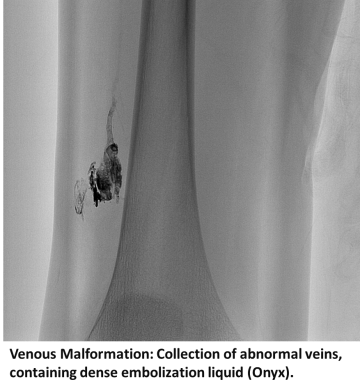Venous and Lymphatic Malformations
Find your care
Our board-certified physicians diagnose and treat many vascular conditions. Call 310-481-7545 to learn more about interventional radiology services.
What are venous and lymphatic malformations?
Venous malformations are abnormally enlarged veins present at birth. Blood flows through venous malformations relatively slowly and they are typically asymptomatic. If present superficially, venous malformations can manifest as soft blue patches or masses that can occur anywhere in the body. Lumps on the face, limbs, or trunk are common locations where venous malformations occur.
As a child grows, venous malformations will also grow. Pregnancy and birth control pills can also cause venous malformations to enlarge. Large venous malformations can potentially compress nerves, impacting motor control and sensation in affected areas. Venous malformations can allow blood to pool, which can lead to clot formation, infection, and inflammation.
Lymphatic malformations are similar to venous malformations, but are formed by abnormally enlarged lymphatic vessels. Normal lymphatic vessels drain excess fluid from tissues and eventually recycle this fluid back into your veins. In lymphatic malformations, fluid drains more slowly and pools in the enlarged area. Lymphatic malformations can become infected and cause pain, leak out of the skin, or bleed. Depending on where it is located, nearby organs can also be affected.

Risk Factors
Venous and lymphatic malformations form during fetal development and are present at birth, but they may or may not be noticeable at birth. Causes are not known, but if multiple venous or lymphatic malformations are present, there may be a heritable cause.
Symptoms
Venous and lymphatic malformations are present at birth and are often asymptomatic. Over time, they can grow and develop the following symptoms:
- Soft blue patches or cystic masses of veins below the skin
- Drains when elevated; enlarges when dependent
- Decreased motor control and sensation
- Raised bubbles or cystic masses of clear or red, bloody fluid below the skin
- Enlarged body part where lymphatic malformation is located
Diagnosis
Physical exam can detect superficial and some deeper venolymphatic malformations, however more advanced imaging tests are used to determine the extension of the malformation into deeper tissues.
- Magnetic resonance imaging (MRI)
- Computed tomographic (CT)
Treatments
- Venous and lymphatic malformation embolization
For More Information:
For more information or to schedule an appointment with one of our IR physicians, please call 310-481-7545.